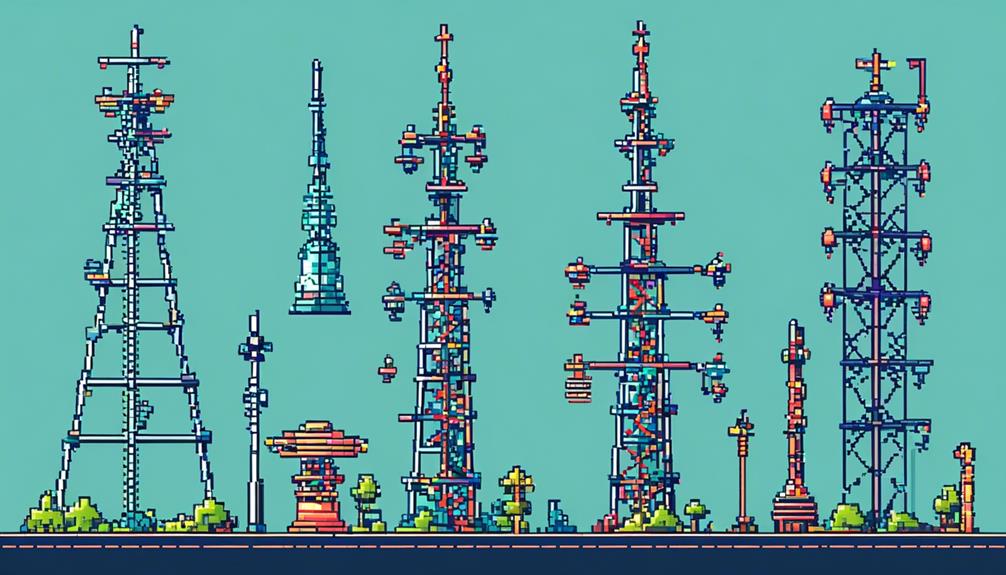Telecommunication towers are the backbone of modern communication networks, providing the infrastructure necessary for wireless communication across vast distances. These towering structures may seem simple at first glance, but they are complex systems designed to facilitate the seamless transmission of voice and data signals.
Understanding the intricacies of telecommunication towers is crucial for professionals in the field, as they play a pivotal role in ensuring reliable network coverage. From the types of towers used to the components that make them function, this discussion will delve into the fascinating world of telecommunication towers, shedding light on their design, construction, installation, maintenance, safety standards, and even future trends.
So, let us embark on this journey of exploration and unravel the mysteries behind these towering giants that connect us all in the digital age.
Key Takeaways
- Telecommunication towers come in various types, including lattice towers, monopole towers, guyed towers, and stealth towers, each with their own unique features and suitability for different environments.
- Telecommunication towers play a crucial role in providing signal coverage and ensuring reliable connectivity for wireless communication devices.
- The components of a telecommunication tower include antennas, transceivers, baseband units, power sources, cabling, and shelters, all working together to transmit and receive signals.
- Telecommunication tower design, installation, maintenance, and optimization are influenced by factors such as signal coverage requirements, geographical terrain, transmitter power, frequency band, antenna height, and network capacity. Safety standards and future trends, such as the transition to 5G technology and the incorporation of small cells, are also important considerations.
Types of Telecommunication Towers

There are four main types of telecommunication towers: lattice towers, monopole towers, guyed towers, and stealth towers. These towers play a crucial role in enabling wireless communication by providing a platform for the installation of radio equipment and antennas.
Lattice towers are characterized by their lattice-like structure, which offers flexibility and self-supporting capabilities. They are commonly used in areas with high wind loads and can accommodate multiple antennas. Lattice towers are often employed as a base station for mobile devices, ensuring widespread signal coverage and reliable communication.
Monopole towers, on the other hand, consist of a single vertical pole. They are aesthetically pleasing and blend well with urban environments. Monopole towers are usually found in densely populated areas where space is limited. Despite their smaller size, they can support multiple antennas and provide adequate signal coverage.
Guyed towers are constructed with a central mast and guy wires that provide additional stability. These towers are cost-effective and suitable for areas with moderate wind loads. Guyed towers are commonly used in rural areas where land is abundant, and they can support a variety of antennas for wireless communication.
Stealth towers are designed to blend seamlessly into the surrounding environment, minimizing their visual impact. They are often more expensive than other types of towers due to their unique design. Stealth towers are commonly used in residential areas or locations where aesthetics are a priority.
Roles of Telecommunication Towers
Telecommunication towers play a crucial role in providing signal coverage for wireless communication devices.
The tower structure, including components like antennas and transceivers, enables the transmission and reception of signals, ensuring reliable connectivity.
Tower Structure
Various types of telecommunication towers play vital roles in facilitating wireless communication for mobile devices, enabling voice calls, text messages, and internet access. A cell tower, also known as a cell site, serves as the central hub for transmitting and receiving signals from mobile devices, allowing communication between mobile devices.
The tower structure consists of various components, including antennas, transceivers, baseband units, power sources, cabling, and shelters. Antennas are responsible for transmitting and receiving signals, while transceivers handle the conversion of wireless signals into digital data. Baseband units process and control the transmission and reception of signals. Power sources provide the necessary energy for the tower's operation, and cabling ensures the connection between the different components. Shelters protect the sensitive radio equipment from environmental elements.
Understanding the tower structure is essential for optimizing wireless communication and ensuring effective transmission and reception of signals.
Signal Coverage
Signal coverage is a crucial function fulfilled by telecommunication towers, allowing seamless wireless connectivity for mobile devices. Here are four key aspects related to signal coverage in telecommunication towers:
- Range of a cell: Telecommunication towers are strategically placed to ensure maximum coverage. The range of a cell tower's signal coverage depends on various factors such as landscape features, transmitter power, and network size. These towers facilitate wireless communication by transmitting and receiving signals through multiple antennas mounted on a head frame.
- Poor cell phone signal: In areas with weak network coverage, the nearest cell tower might be too far away, resulting in a poor cell phone signal. To address this issue, telecommunication companies are constantly expanding their network coverage by building new towers or upgrading existing ones.
- Types of cell towers: There are different types of cell towers, including monopoles, guyed towers, and self-supporting towers. Each type is designed to meet specific requirements based on factors like location, terrain, and capacity.
- Radio equipment and communications equipment: Telecommunication towers house various radio equipment and communications equipment, including transceivers, cabinets, and shelters. These components play a crucial role in transmitting and receiving radio waves, ensuring uninterrupted wireless communication.
Tower Design and Construction

Tower design and construction encompasses different types of structures, each serving specific purposes and adhering to aesthetic requirements. Cell towers are crucial components of the telecommunication infrastructure, facilitating wireless communication for mobile devices. These towers are equipped with multiple antennas, transceivers, baseband units, power sources, cabling, and shelters to ensure smooth operation.
To better understand the different types of cell towers and their specifications, refer to the table below:
| Tower Type | Description | Use |
|---|---|---|
| Lattice Towers | Made of steel and composed of interconnected metal beams forming a lattice structure. | Commonly used for urban areas or locations with limited space. |
| Monopole Towers | Consist of a single self-supporting pole made of steel or concrete. | Often utilized in rural areas or locations with fewer aesthetic restrictions. |
| Guyed Towers | Supported by guide wires anchored to the ground, providing stability. | Frequently employed in areas with high wind loads or geological instability. |
| Stealth Towers | Designed to blend with the surrounding environment, often disguised as trees or flagpoles. | Primarily used in areas where aesthetic considerations are paramount. |
Tower design and construction also involves considering the range of a cell tower, which is influenced by factors like geographical terrain, transmitter power, frequency band, antenna height, and design. Additionally, the evolution from 4G to 5G technology requires hardware and infrastructure upgrades, including the integration of Massive MIMO technology, higher frequency bands, Remote Radio Heads (RRHs), Baseband Units (BBUs), and the shift from coaxial cables to fiber optic cables.
When designing cell towers, conducting structural analysis is crucial to understand the tower's response to loads and stresses. This analysis helps identify potential weaknesses and ensures the tower can withstand environmental forces such as wind and seismic loads. Overall, tower design and construction play a vital role in establishing reliable telecommunication networks and supporting the growing demand for wireless connectivity.
Components of a Telecommunication Tower
The components of a telecommunication tower encompass a range of essential equipment and structures that enable wireless communication. These components play a crucial role in ensuring the seamless transmission of voice, data, and other forms of communication.
Here are four key components commonly found in cell towers:
- Antennas: Cell towers use antennas to transmit and receive signals. These antennas are strategically positioned on the tower to provide optimal coverage and ensure efficient communication between the tower and connected devices.
- Transceivers: Transceivers are responsible for converting electrical signals into radio waves and vice versa. They receive incoming signals from connected devices and transmit them to the appropriate destination, whether it's another device or a network.
- Baseband Units: Baseband units are essential for processing and managing the data traffic within the cell tower site. They handle tasks such as signal modulation, demodulation, and protocol conversion, ensuring that data is transmitted accurately and efficiently.
- Power Sources and Shelters: Cell towers require a reliable power source to operate continuously. Power sources can include electrical grid connections, backup batteries, or generators. Additionally, shelters are often built at the base of the tower to house the necessary equipment and protect it from the elements.
With years of experience in the industry, wireless carriers understand the importance of these components and the need for well-designed and constructed cell towers. By using state-of-the-art equipment and adhering to industry standards, they strive to provide reliable and efficient communication services to their users.
Installation and Maintenance of Telecommunication Towers

Installation and maintenance of telecommunication towers involve meticulous assembly, setup, and regular inspections to ensure the reliability and safety of wireless communication infrastructure. These tasks are crucial for maintaining a high-performing network and providing seamless connectivity to users.
The installation process begins with site preparation, where the tower's foundation is constructed to support its weight and withstand environmental forces. Once the foundation is completed, the tower sections are assembled, ensuring proper alignment and connection. Equipment such as antennas, base transceiver stations, and power sources are then installed on the tower.
Regular inspections are often conducted to identify any structural issues or equipment malfunctions that could affect the tower's performance. These inspections involve visual assessments, structural analysis, and testing of tower components. It is essential to detect and address any problems promptly to prevent service disruptions or compromising the safety of the tower.
In the United States, different types of towers are used to accommodate specific cell coverage requirements. For example, monopole towers are commonly utilized in urban areas due to their space-efficient design. On the other hand, lattice towers are often employed in rural locations where tall structures are necessary to cover larger areas.
Telecommunication towers play a critical role in transmitting and receiving signals, allowing users to access wireless services. They serve as the backbone of the communication network, facilitating the flow of data and enabling seamless connectivity. Therefore, proper installation and maintenance of telecommunication towers are essential to ensure reliable wireless communication and network coverage for specific cells.
Network Coverage and Telecommunication Towers
To ensure reliable network coverage, signal strength analysis is crucial in determining the placement and optimization of telecommunication towers. Through strategic tower placement, wireless carriers can maximize signal coverage and minimize signal interference.
Mobile network optimization techniques are employed to fine-tune network parameters and improve overall network performance, ensuring seamless connectivity for users.
Signal Strength Analysis
Signal strength analysis plays a critical role in assessing network coverage and evaluating the performance of telecommunication towers. Here are four key aspects of signal strength analysis:
- Measurement: Signal strength analysis involves measuring the strength of radio signals received from telecommunication towers. This data is essential for determining the quality of coverage in specific areas.
- Network Coverage Maps: By analyzing signal strength data, network coverage maps can be created. These maps help users identify areas with strong or weak coverage, enabling them to make informed decisions about their cellular network usage.
- Optimization: Telecommunication companies, like Crown Castle and American Tower, rely on signal strength analysis to optimize their network coverage. This analysis helps them identify areas with poor coverage and determine the need for additional cell towers or network adjustments.
- Antennas and Frequency Bands: Signal strength analysis also considers the antennas mounted on telecommunication towers and the use of higher frequency bands. These factors impact the strength and reliability of the digital signals received by cell phones.
Tower Placement Strategy
Tower placement strategy is a crucial aspect of optimizing network coverage and ensuring seamless communication and connectivity for mobile network users. When planning the placement of cell towers, several factors are considered to provide reliable wireless coverage and capacity.
The strategy takes into account areas with high population density, the physical structure of the surrounding area, and the equipment and antennae required for efficient wireless networks. By analyzing terrain and signal propagation, tower placement is determined to minimize coverage gaps and maximize signal strength.
Additionally, the frequency bands, antenna height, and transmission power are carefully chosen to provide effective coverage. The goal of tower placement strategy is to enhance network reliability and ensure that modern cell users have uninterrupted and high-quality communication experiences.
Mobile Network Optimization
When optimizing mobile networks for optimal coverage and performance, the strategic placement of telecommunication towers is of utmost importance. Here are four key aspects of mobile network optimization:
- Coverage and Capacity Expansion:
Telecommunication towers are strategically placed in areas where network coverage is weak or nonexistent. By expanding coverage, these towers ensure that mobile users can access network services in a wider range of locations.
- Power Systems and Components:
Cell towers require reliable power systems to operate effectively. This includes backup power solutions to ensure uninterrupted service during power outages. Additionally, the components of cell towers, such as antennas and transmitters, need to be properly maintained and upgraded to support the latest technology.
- Reception of Radio Frequency:
Telecommunication towers transmit and receive signals in the radio frequency spectrum. To optimize network performance, towers must be designed to minimize interference and maximize signal quality, ensuring clear communication between mobile devices and the network.
- Health Risks and New Technology:
The placement of telecommunication towers must also consider the potential health risks associated with radio frequency exposure. As new technologies emerge, such as the transition to 5G, tower placement and design must adhere to stringent safety guidelines to protect public health.
Telecommunication Tower Safety Standards
To ensure the safety of workers and the public, telecommunication tower safety standards establish regulations and guidelines that address all aspects of structural integrity, fall protection, electrical safety, RF exposure limits, and emergency response procedures. These standards are particularly useful for cell towers, as they are often placed high above ground level and are associated with cell phone networks.
One key aspect of telecommunication tower safety standards is ensuring the structural integrity of the towers. Due to their height and exposure to various weather conditions, towers are usually subjected to significant stresses. Regular inspections and maintenance are essential to identify any signs of structural deterioration and ensure that towers meet safety standards.
Another critical aspect of safety standards is fall protection. Workers who climb towers for construction, maintenance, or repair purposes face inherent risks. Safety guidelines mandate the use of appropriate safety equipment, such as harnesses and lanyards, to prevent falls and protect workers from serious injuries or fatalities.
Electrical safety is also a vital component of telecommunication tower safety standards. Towers contain electrical components that are necessary for transmitting and receiving signals. Safety standards dictate proper grounding, insulation, and labeling of electrical equipment to minimize the risk of electrical accidents or fires.
RF exposure limits are another important consideration. Towers emit radiofrequency (RF) waves at a specific frequency to facilitate wireless communication. Safety standards specify maximum allowable exposure limits to protect workers and the public from excessive RF radiation.
Lastly, telecommunication tower safety standards also address emergency response procedures. Protocols for incidents such as fires, equipment failures, or other emergencies are established to ensure a swift and coordinated response to protect lives and property.
Future Trends in Telecommunication Towers

With the continuous advancement of telecommunication tower safety standards, the focus is now shifting towards exploring the future trends in the industry.
- Transition to 5G: As the demand for faster and more reliable connectivity increases, telecommunication towers will need to evolve from 4G/LTE to 5G technology. This transition will require hardware and infrastructure upgrades to support the higher data rates and low latency requirements of 5G networks.
- Massive MIMO Technology: Future telecommunication towers will incorporate Massive Multiple-Input Multiple-Output (MIMO) technology. This technology allows for the use of multiple antennas to increase spectral efficiency and extend the range of cellular communication. By using multiple antennas, telecommunication towers can handle thousands of connections simultaneously, making them suitable for densely populated areas.
- Fiber Optic Connectivity: Cell towers will see a shift from coaxial cables to fiber optic cables for improved data transmission and higher power requirements. Fiber optic cables can transmit data at much higher speeds and over longer distances, making them essential for supporting the increased bandwidth demands of future telecommunication networks.
- Small Cells: To cater to the growing demand for connectivity in rural areas and high population density areas, telecommunication towers will incorporate small cells. These are low-power, short-range wireless access points that can be deployed in strategic locations to enhance network coverage and capacity. Small cells enable improved connectivity in areas where traditional telecommunication towers may face challenges in providing adequate coverage.
Frequently Asked Questions
How Does a Telecom Tower Work?
A telecom tower works by receiving and transmitting signals through its antenna technology, enabling signal propagation for wireless communication. It utilizes radio frequency transmission to connect calls to mobile phones or telephone networks, ensuring network coverage.
Tower maintenance is crucial for optimal operation, and tower height regulations and tower sharing agreements are in place to ensure safety and efficient use of resources. Measures are taken to prevent tower collapse and to promote tower energy efficiency.
Careful tower location planning is also essential for effective coverage and signal quality.
What Are the Different Types of Telecom Towers?
Telecommunication towers play a crucial role in the modern communication infrastructure. They come in different types such as lattice towers, monopole towers, guyed towers, and stealth towers. These towers have evolved over time to meet the increasing demands of connectivity.
They are especially important in rural areas, where they provide essential communication services. However, building telecom towers faces challenges such as land acquisition and environmental impact.
In the future, innovative designs and cost considerations will shape the construction of telecom towers. They also play a significant role in disaster management, providing critical communication during emergencies.
What Are the Components of a Telecommunication Tower?
A telecommunication tower consists of various components that are crucial for its proper functioning. These include:
- Tower infrastructure: provides the physical support for antennas and other equipment.
- Antenna placement: essential for optimal signal coverage.
- Tower maintenance: ensures the smooth operation and longevity of the tower.
- Structural integrity: ensures the tower's stability and safety.
- Power supply: ensures continuous operation.
- Equipment shelter: protects sensitive equipment from environmental elements.
- Lightning protection: safeguards the tower from lightning strikes.
- Tower climbing safety: measures ensure the safety of personnel during maintenance and inspections.
- Radiofrequency exposure: concerns the potential health risks associated with electromagnetic radiation.
- Environmental impact: refers to the ecological consequences of tower installation and operation.
How Can I Tell Which Cell Tower I'm Connected To?
To determine the cell tower you are connected to, you can check the signal strength on your device. Various tools and techniques, such as tower mapping apps and websites, can help identify the specific tower. However, determining the physical location of the tower may require additional research.
Ownership information can be obtained from regulatory authorities or tower companies. Tower upgrades occur periodically to improve network capacity and coverage. High tower congestion can be avoided by connecting to less crowded towers nearby. Interference with the tower may be caused by factors such as physical obstacles or radio frequency interference.
Tower inspections and maintenance are conducted regularly to ensure optimal performance. The maximum number of devices a tower can handle affects connectivity, with overcrowded towers potentially leading to slower speeds and dropped calls.

